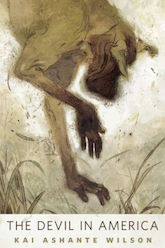In February of 2016, Fantastic Stories of the Imagination published an essay by me called “A Crash Course in the History of Black Science Fiction.” In the two years since, Tor.com has published my in-depth essays on thirteen of the 42 works mentioned. The original “Crash Course” listed those 42 titles in chronological order, but the essays skip around. In this fourteenth column I write about “The Devil in America,” one of the first professionally published stories by rising star Kai Ashante Wilson.
A ROUGH ONE
 Using a nontraditional format, Wilson begins his story about an imagined nineteenth-century tragedy with a twentieth-century father’s reflections on real life anti-black violence in his own time. Just the victims’ names—Emmett Till, Amadou Diallo, Arthur McDuffie—evoke unavoidable brutality, the sort of waking nightmare that many an African American knows lies just below the surface of the mundane world. The reading doesn’t get any easier when Wilson brings his narrative skills fully to bear on describing the destruction of the fictional Rosetree.
Using a nontraditional format, Wilson begins his story about an imagined nineteenth-century tragedy with a twentieth-century father’s reflections on real life anti-black violence in his own time. Just the victims’ names—Emmett Till, Amadou Diallo, Arthur McDuffie—evoke unavoidable brutality, the sort of waking nightmare that many an African American knows lies just below the surface of the mundane world. The reading doesn’t get any easier when Wilson brings his narrative skills fully to bear on describing the destruction of the fictional Rosetree.
SWEETNESS AND DARK
But before subjecting us to that, the author involves us in the inner cares and delights of Easter Mack, daughter of the handsome and commanding Hazel Mae Mack, whom she calls “Ma’am.” In August 1877, twelve-year-old Easter gives dinner scraps to her brother, who years before turned himself into a dog and got stuck that way. She makes sure a special hen stays on guard against evil, vibrates with the rising urgency of the promise of her friend Soubrette’s kiss, and persuades the angels invisibly filling the air around her to relight a blown-out candle. And she’s sure the rain threatening the Rosetree church’s annual picnic won’t fall on it—though thanks to the story’s opening, readers understand that something else will.
NO TIME, NO WAY
Easter understands that her doom is approaching, too—as well as any child can understand such a thing. Shifting his narrative to 1871, six years earlier, Wilson recounts how, in her childish pride, Easter bargained away the precarious peace and well-being wrought by her ancestors. Taken to a spot in the tobacco fields where Ma’am and Daddy weren’t ever supposed to take her, “no time, no way,” the six-year-old encounters a tricksy entity who calls himself “the banker.” As underscored by multiple epigraphs, and as Hazel herself points out in direct speech, knowledge of ancestral techniques for overcoming this entity’s malice have been stripped from African Americans by generations of enslavement. Whether six or twenty-six, Easter would be unequipped to deal wisely with this supernatural banker. In 1877 her safeguards fail. The banker’s payments come due. Her family and community are going to be slaughtered.
NO NO NO NO NO
The day of the fated celebration dawns. Again Wilson lulls the wariness he has roused in his readers, comforting us with cozy details about vases of flowers and picnic foods and the itinerant preacher’s sermon. But soon blood and bullets fly. The sensory immediacy so pleasant mere paragraphs earlier guts us. “To cry hard enough knocks a body down, and harder still needs both hands flat to the earth to get the grief out,” the author explains, emotion conveyed in terms of physical effort. An old neighbor man crossing his porch with the help of his cane dies before he knows what’s hit him. Scared children running fruitlessly away are shot in the back. Hazel offers herself as a sacrificial distraction, which allows Easter to escape with her canine brother by succumbing to the same spell that holds him in its sway. Temporarily.
BLAME
Who’s at fault for this horror? Not Hazel Mae, making the best use she knows how of the “old Africa magic” she has inherited. Not little Easter, trying to improve her family’s lot without proper tools and training. Not even the devil-possessed white men murdering and raping their way through a peaceful, unarmed community. Wilson provides a quotation from the nonexistent (as far as I can tell) anthropological text White Devils/Black Devils to make plain the real culprit: the uprooting effects of the Transatlantic slave trade and the dehumanizing racism based on it. Racism is a system, a “peculiar institution” supported by individuals’ acquiescing actions but as a whole affecting the world far more widely than any one of these. It has distorted the very nature of its captives’ deity, making of the amalgamation of ambivalent West African trickster figures a wholly malevolent entity, gorging on their suffering.
CALL ME
Wilson is a supernal writer, and I have no hesitation in recommending his work. In general. At this point there are only a few short stories, a novelette, and two novellas; he creates at a self-admittedly glacially slow pace. Unlike “Super Bass,” “Légendaire,” “A Taste of Honey,” “The Sorcerer of the Wildeeps,” and his most recent publication “The Lamentation of Their Women,” though, this novelette needs a post-read counseling session. So I’ve taken to offering phone consultations to anybody accepting and following through on my recommendation. Same to you. Email me at the AOL address on the bottom of my website’s main page and I’ll respond with my number. We’ll talk.
I COULDN’T HAVE
Writing that moves me deeply usually falls into one of two categories. Either it’s something I would never have thought of doing, or it’s something I’ve thought of doing but never dared. “Devil” is one of the latter sort. Could I have ever brought to vivid life one of those hellish scenes of mass murder so often repeated they’ve become a race memory? No. Not for any money. Not for any reward of any sort.
But Wilson did. And beautifully. Come marvel with me at what he’s done.
 Nisi Shawl is a writer of science fiction and fantasy short stories and a journalist. She is the author of Everfair (Tor Books) and co-author (with Cynthia Ward) of Writing the Other: Bridging Cultural Differences for Successful Fiction. Her short stories have appeared in Asimov’s SF Magazine, Strange Horizons, and numerous other magazines and anthologies.
Nisi Shawl is a writer of science fiction and fantasy short stories and a journalist. She is the author of Everfair (Tor Books) and co-author (with Cynthia Ward) of Writing the Other: Bridging Cultural Differences for Successful Fiction. Her short stories have appeared in Asimov’s SF Magazine, Strange Horizons, and numerous other magazines and anthologies.










